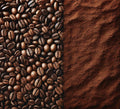The main difference between light and dark roast coffees is the roasting time.
Light roasts are roasted for a shorter period of time than dark roasts. This means that light roast coffees will have more caffeine than dark roast coffees.
Dark roast coffee beans will also have a more intense flavor since the longer roasting time allows for more caramelization of the coffee beans.






















